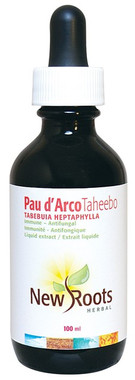- Home
- Health Condition
- Candida/Yeast
- New Roots Pau d’Arco Taheebo (Liquid), 95 ml
Product Description
Pau d’arco has been found to have antibacterial, antiviral, antiparasitic, and antifungal properties, including anti-Candida, anticancer, and antitumour properties. Liquid extract.
Ingredients
| Each ½ teaspoon contains a crude quantity equivalent of: | |
| Lapacho (Tabebuia heptaphylla) bark | 900 mg |
Suggested Use
Detailed Description
Pau d’arco has been deeply prized by many of the indigenous tribes of South America. They were well-aware of pau d’arco’s numerous health benefits, and used it for just about every health problem. It has been suggested that pau d’arco can help cancer patients deal with symptoms and pain.
This amazing herb has been found to have antibacterial, antiviral, antiparasitic, and antifungal properties, including anti-Candida, anticancer, and antitumour properties.
Perhaps pau d’arco’s most impressive use may be its reputation for fighting cancer. Since 1960, medical doctors in South America, at the Santo Andre hospital, have used pau d’arco to treat terminally ill cancer patients. Well-known herbalists report that pau d’arco cures leukemia and reduces pain in cancer patients. It also increases blood-cell counts, enabling it to fight many illnesses.
Pau d’arco uses are many: it is also used to treat ulcers, diabetes, rheumatism, ringworm, bronchitis and other respiratory problems, gonorrhea, hemorrhages, cystitis, colitis, gastritis, Parkinson’s, arteriosclerosis, Hodgkin’s, lupus, polyps, prostatis, leucorrhea, candidiasis, endometriosis, fibroids, cysts, growths and tumors, anemia, and inflammation of the urinary tract, just to mention some of this incredible herb’s uses.
Its anticancer properties were first attributed to a phytochemical found in the bark and wood, called lapachol. In a 1968 study, lapachol demonstrated highly significant activity against cancerous tumours in rats. Another research group developed a lapachol analog in 1975, which was effective in increasing the lifespan by over 80% in mice inoculated with leukemic cells. In a small study in 1980 with nine patients with various cancers (liver, kidney, breast, prostate, and cervix), pure lapachol demonstrated an ability to shrink tumours and achieved complete remissions in three of the patients.
Pau d’arco is known to eliminate toxins in the body and purify the blood. In an original weight-loss research study performed in Chicago in 1992, women’s chronic yeast infections cleared up promptly when pau d’arco was added to the formula. Pau d’arco also has anti-inflammatory characteristics, making it useful in the treatment of arthritis and other inflammatory diseases.
The safest and best part of the herb to use is the whole inner bark, brewed as a tea.
 Loading... Please wait...
Loading... Please wait...











